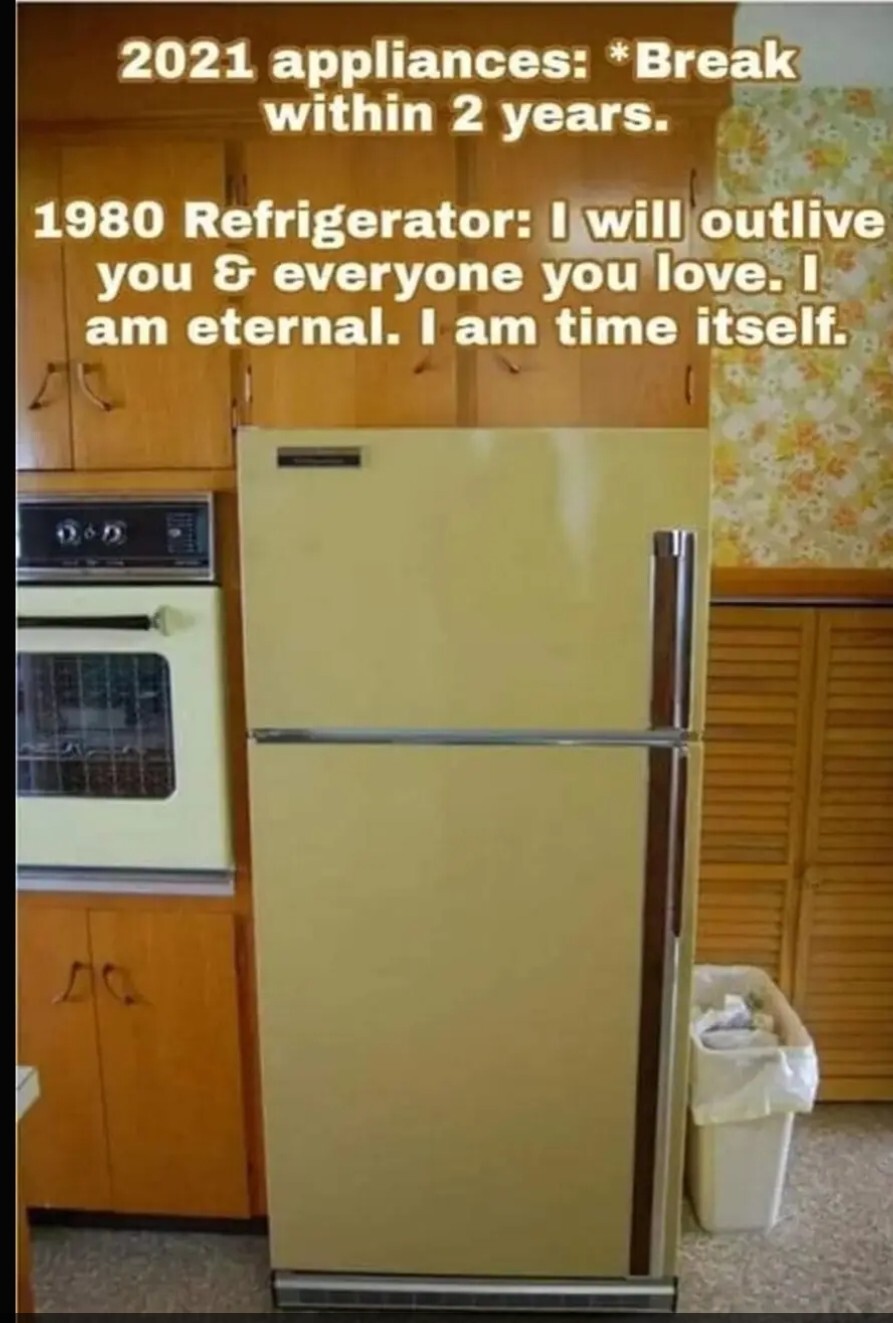Planned obsolence should be illegal
Won’t anybody think of the poor shareholders? Planned obsolescence is what keeps this whole system running.
God that’s a pet peeve of mine, people who think they’re the sole component about why something works, when what’s working works IN SPITE of them.
Shareholders definitely qualify.
Seriously, no one is going to mention “Right To Repair”? If this was law, and companies had to divulge how there stuff worked and was assembled, as well as sell parts, things would last longer. If every trade zone had a repairablity index, competition would make things last longer still.

Will use 4x as much electricity though, ugh.
https://www.cleanenergyresourceteams.org/your-old-refrigerator-energy-hog
Anyone know of any refrigerators today that are as durable as older ones and have today’s efficiencies, but without the smart features and other junk?
Average refrigerator today still lasts 13 years though, and while they’re made cheaply they also are cheaper (at least as a portion percentage of the average paycheck).
https://reviewed.usatoday.com/dishwashers/features/ask-the-experts-why-dont-new-home-appliances-last
Sub Zero, Thermador… High end refrigerators, just look at the price, we decided to forget the idea because of that.
I’ve heard that in the US fridges are generally different, with stuff like active fans and nonsense like that. Is that true?
Because every fridge I’ve seen in Europe is mechanically extremely basic and I’ve literally never seen or even heard of one breaking. In my experience fridges are one of the only things that have remained phenomenally simple in design and extremely unlikely to break.
If someone told me their fridge broke, I’d genuinely assume they were lying. That’s how reliable they are.
Well there are evaporator fans in modern refrigerators in the US. They serve an important role though helping with defrosting, improving cooling efficiency, and evenness of cooling throughout the fridge.
https://refrigeratorguide.net/maximize-cooling-efficiency-best-refrigerator-evaporator/
Usually only very small refrigerators are without them now.
It is another point of failure though, but should be pretty easily repairable. I mean it’ll still be able to cool without the fan, but it’ll be running much more to try and compensate and keep things cool though.
If you know the YouTube channel technology connections, here’s a fun video of him messing around with a fanless style refrigerator:
Every LG and Samsung major appliance I’ve had has broken within 5 years.
Refrigerators, washing machines, and dryers.
Prior, I only ever had 80s era American tank energy hogs. Switched back to American brands in the last few years, so too soon to tell if they’ll work out better…
Here’s to hoping.
Oh, and having dealt with LG warranty for both electronics and major appliances, I’ll never buy another LG product that isn’t a monitor.
LG monitors are the only higher end LG product’s I’ve owned that have survived well past the warranty date.
I think Samsung is generally considered trash now. I certainly will never buy any of their “smart” objects either, especially not an ad-ridden TV.
We have a refrigerator from the '80s that runs like a champ.
Solved the energy problem by putting solar panels on the roof.
Can confirm. Use a fridge from 1974. 2 years ago thermostat failed. Replaced with digital one for $15. Now have a nice digital readout of the temps. Thing uses
180W100W when running, less than bigger newer ones.
It’s even more ecological to keep it running since it still has the nasty ozone layer killing coolant that would partly evaporate when trashing it.EDIT: 100W just checked the type plate.
I haven’t looked at the statistical data on this myself, but there’s something to be said for survivorship bias.
Not to mention those old fridges are Horribly inefficient on energy
forever cars no make profit line go up
Time to make a billion dollars on something else, then start up a car company designed to fail. No investors, design a car for a 60-70k buying price, few bells and whistles, but built to last indefinitely with basic maintenance. Start the company planning to practically close it down just after the last preorder customer has their car delivered and become a maintenance company with a few employees to make replacement parts and install them. If demand rises, redesign for the new times, ramp up and do it all again.
Who wants an infinite lifespan car anyway? Everything else would be getting safer and more fuel efficient. Might as well get around on horse and buggy.
My family bought an electric forklift for their factory in the early 90s. I think it is a Yale.
My sister has since taken over the forklift for her company and she has only replaced the batteries and the controller once.
These things are cheap to replace and not as much of a mystery as ICE engines.
I am seeing people replace old Prius hybrid batteries themselves with basic tools now.
I think the only thing I would be concern about is the crash safety for cars. Newer cars are safer. I think that would be the only draw to buy a newer vehicle.
I was going to scoff at the Prius…the battery is only 1500$.
I need a Prius frame in an El Camino body.
I’m sure someone has a kit for that.
Surely the free market and competition will deliver what customers want, right? … Right?!?
Good luck with that. Planned obsolescence is a key ingredient in capitalism. I mean what better way to make line go up than to turn a one-time purchase into a repeat purchase? This shareholders and executives will never be able to step on the working class if they can’t gouge customers. Won’t anyone think of the shareholders?
After ~20-30 years, rubber gaskets and seals and cable insulation start failing. Plastic becomes brittle, especially if exposed to the sun. How do they solve this problem?
I would think an electric vehicle would have quite a lot fewer things like gaskets and other seals since gas isn’t involved. Other than the normal wear and tear items like brakes, shocks, rotors, etc, battery repair would be the major thing I’d expect to need work. I imagine many mechanics aren’t trained to handle these, so they end up just replacing the whole unit. Obviously this is wasteful though but could be easily solved via training.
Pretty much this, diagnosing and fixing an electric motor is about as difficult as an alternator. Check signal, if good remove unit and swap (core gets remanufactured). With drive by wire and steer by wire and all that most things are equally modular. Gas pedal/throttle unit is pretty much a rheostat with a spring-loaded pedal, steering rack actuators, etc
Then you got ICE which becomes a ship of theseus. If you put enough hours on a combustion engine you go from the simple stuff like hoses and timing belts to having to replace piston rings, bearings, or even the cylinder heads if they get so worn out that they leak and fail compression tests
Spoken like someone that doesn’t work on cars.
Cars used to be much more modular. Newer models of car - much like newer models of cell phone - are deliberately engineered to be difficult to disassemble and fix, in order to compel people to replace the whole vehicle on a tighter time frame.
Yep. Like Tesla with its large castings. Makes the cars unrepairable. EV’s are the worst at this too.
It was a big reason for the surge in popularity of Japanese cars, during the 80s/90s. Honda Civics were famously very easy to mod, leading to the trend of “Rice Rocket” cheap urban street racing cars. That’s fallen off substantially in the last ten years, thanks to Japanese companies becoming infested with Wall Street / McKinley Consultant profit-chasers. Toyota and Hyundai might as well be run by the CEO of GM, the way they build their vehicles.
But a lot of the new Indian and Chinese vehicles are adhering to more traditional modular manufacturing style. They’re also having a really hard time getting their vehicles into Western dominated car-markets, for some curious reason.
In April, a group of people in a red Tesla driving through the Moroccan desert were glued to the odometer on the car’s giant touch screen. “Two million, Hans! Two million,” exclaimed the front-seat passenger to the owner and driver, Hansjörg von Gemmingen-Hornberg.
Ah, it’s gonna be one of those fluffy wanker articles.
Also paywalled.
So lame.
I mean most things can, it just isn’t profitable…
Planned Obsolescence, baby!
That said, we might be able to make industrial scale recycling an economically efficient activity if we build more durable goods with a longer lifecycle and limit the availability of new territory to strip mine and abandon.
So much of our “cheap” access to minerals and fossil fuels boils down to valuing unimproved real estate as at zero dollars and ignoring the enormous waste produced during the extraction process. Properly accounting for the destruction of undeveloped real estate and the emissions/waste created during industrial processing could dramatically improve how much waste we produce and - consequently - how long our durable goods last.
deleted by creator
But ending capitalism to make good products that satisfy user need kills 100 zillion people.
deleted by creator
I’ve been taught that capitalism is all about innovation… So I’m sure the perfect long life car is just around the corner, they wouldn’t actually just build crappy cars just to force us in a never ending cycle of consumerism, right?.. Right?
/S … in case it wasn’t on the nose enough
My uncle bought a used car built in communist east Germany. He always emphasized how it was built like a tank to last. Capitalism is great and all, but it promotes waste. Companies have an incentive to make products that fail and need to be repurchased. Planned obsolescence is fine if it was only about people craving something better. As it stands, it’s more of a forced switch with breakable parts.
deleted by creator
Same goes for light bulbs
LED bulbs last pretty much forever.
They get dimmer over time. And they do it gradually so you don’t notice it until you buy a new one and realize how dim the old one was
LEDs themselves don’t get dimmer and don’t fail. Their drivers fail and run LEDs at higher voltages so then LEDs burn out. If the LED is driven correctly, it won’t dim over time and will last pretty much forever in terms of human lifescales.
Most LEDs run on DC, and the built-in transformer is the most likely component to fail. If the LED is failing and getting dimmer, it’s most likely due to poor heat dissipation.
If we had little 12v adapters and separate LED modules, you could reduce waste by only replacing the part that fails, and manufacturers would have greater incentive to improve build quality. Instead, we get cheaply manufactured bulb-shaped disposable units that need to be thrown away when one part fails.
Honestly considering going to DC lighting after my solar conversion completes at my house for this reason
I have some dc lighting in my basement. It’s great, but there aren’t as many options out there and electricians don’t want to touch it.
Electricians don’t want to touch DC circuits because it is illegal to mix low voltage DC and high voltage AC circuits. At least it’s illegal in Europe. You need to rebuild your walls to ensure separate and independent wiring channels. And that’s a very expensive nightmare.
It’s a lot cheaper to buy Philips bulbs instead.
Yeah, I definitely get it. It would be illegal to mix low and line voltage in the USA, too.
I ended up running the cabling myself, all class two circuits powering 12 24vdc spots. The nice bit is that they are all addressable RGBW spots, so I can control them all individually or as groups. And it’s all automated. The downside is that I’ll probably have to remove them if we ever sell this house, because nobody but me understands how it works.
Yeah I’ve only ever had one LED bulb die, and I think that was because it was faulty in some way. I’ve had a much better experience with them compared to CFLs.
I’ve had lots of led bulbs die. I think it’s because I bought them at the dollar store.
And finding quality ones that will last a long time is more difficult than you might think.
Many of them are made cheaply.
Just buy Philips bulbs, problem solved!
I bet smartphones could last 3 or 4 years even if companies let them 😏
I’m still using my OnePlus 8t. Phones lifespans are fine. If you can’t keep your phone working for 4 years, that’s on you.
I see no reason to upgrade until support is dropped.
My Samsung a70 doesn’t get major software updates anymore. I’m OK with it. I’ll use this as long as possible.
For security reasons, don’t do that. Don’t use things older than the supported android version. It’s fucking Linux. It gets vulnerabilities.
What are you even doing, throwing your phone on the ground? How does your phone not last that long
I don’t get how people are replacing their phones so damn often. I buy used flagships that are usually a year or two old and rock them for another 4 years. Note 10+ here, and I’ve had it for around 3 years now, probably won’t upgrade for another 2 years, as it’s perfectly fine still.
Trade in value drops very rapidly for non-iphones after a year or two. You can often get 50% back on the purchase by trading in a functional phone.
If you buy a new phone every 2 years or every 4 years, it’s often about the same total out of pocket cost (with a lot of exceptions)
I’ve never paid more than $150 for a phone, and that’s recently for a 2 year old pixel.
I can keep multiple spares around for the price of a new phone.
Like the new LED lightbulbs. Buy one now and they last a year or so. I bought one of them WAY back when they were brand new and horribly expensive and the damn thing still works just fine.
Companies can’t stand new technologies that just work. They have to build in planned obsolescence. See also: smartphones, especially iTrash that make you buy a new one every year or two because updates slow them down.
The problem with LEDs isn’t the bit that emits lights. It’s the power supply, specifically the electrolytic capacitors. Good designs either use higher quality caps, or use designs that avoid electrolytic caps altogether. Either one takes a bit more money, but the market is always in a race to the bottom.
Long term, I think we should be avoiding traditional light fixtures entirely. It’s better to have a lot of little lights spread over an area rather than a few point sources in the room. That gives us the opportunity to separate the power supply from the lights entirely, like LED strips do.
The LEDs will also fail from overheating. LED bulbs don’t last long in fully enclosed fixtures that were designed for incandescent bulbs.
If the bulb starts flickering, that’s usually a bond wire failure in an LED. When the LED heats up the bond wire loses connection and it will reconnect when it cools down again. The LEDs are in series, so if one fails, the entire bulb goes out. Flickering can also be caused by a capacitor failure in a switch mode supply, but most LED bulbs use linear regulators with a high voltage series string of LEDs now, which also increases the chance of a bond wire failure.
The early LED bulbs that cost a fortune had huge aluminum heat sinks to keep them cool. The few that I had all lasted until the LEDs got dim.
The newer designs that use very long, filament-attached LEDs in a large helium filled glass bulb also work quite well, even in a classical light fixture. The helium filling helps with cooling because helium has higher convective heat transfer than air.
Good ones still last a long time. What fails is generally not the LED itself but the cheap-ass rectifier in a cheap-ass case that is optimised for production price instead of heat dissipation. The fixture can also be an issue as nobody designed for heat dissipation in the days of incandescent bulbs, you might be baking those poor capacitors.
And those kinds of bulbs will stay available because there’s plenty of commercial users doing their due diligence on life-time costs. Washing machines, fridges? Yes, those too, though commercial ones aren’t necessarily cheap. Want a solid pair of pants? Ask a construction crew what they’re wearing.
I bought about 20 Cree bulbs 5 years ago, 15 are on about 15 hours a day. I’ve had 2 fail in that time.
Not a bad record in my book.
Even the off brands, IKEA, Amazon, etc, seem to last as long. They’re all in open fixtures, so no cooling issues.
Please elaborate on the iTrash slowdown thing. I have an idea of what you’re referring to but want to make sure I’m right.
iPhones and iPads famously get slower, laggier, and less useful as time goes on. This is not just because of its use because even resetting one will make it just as slow as before. Sure, as we move forward we get more demanding applications and such, but it seriously doesn’t seem like that scales properly with the ability of the hardware, almost like Apple intentionally builds in incremental slowdowns in each patch that isn’t installed on current hardware. It’s apocryphal, I know, but there have been so many people complaining about their perfectly good iDevices suddenly not performing like they used to even after a refresh that makes me feel like there’s at least something to it.
And don’t get me wrong, Android phones seem to do the same to a certain degree. iDevices are just more famous for doing it.
deleted by creator
Gonna downvote you here bröder and chip in with the people defending Apple’s products while recognizing that Apple did go through a lawsuit and that they did indeed participate in this shady-ass practice. Whether they still do - who knows, we live in a funny age.
From personal experience, not only is the build quality superior but they do last pretty long. I’ve got 3 devices personally and have had experience with many more.
My SE that’s old as hell now. I’m not gonna say it runs every app just fine, but the OS functions just fine. I use it as a music player now tho and iPhone 14 as my phone.
SE2 was shit, I’ll admit.
I bought M1 Air when they just came out - it has barely slowed down. Admittedly, it was after my 12 year old Acer plastic clunker decided to not wake up one day.
I also just recently used a friend’s pretty ancient iPad for Procreate and that worked just fine as well.
If someone’s looking for great UI/UX out of the box and great industrial design, what other alternatives are there besides Apple? At least for smartphones there are none. If someone did put a really nice feeling (physically) smartphone in front of me and said: “hey, you can switch everything off with hardware switches and all the apps you’re used to are supported plus the UI and the camera is competent”, I might jump, maybe. Depending on how I could manage my workflow with Linux bc I’m not going to Windows and in this hypothetical scenario if I’m jumping Apple, I’m jumping everything not just the phone.
All that said, I have been giving a thought to all of this for some time and as soon as the time is right for me, I will switch, out of principle. I would love to be able to run some other OS on Apple phone hardware tho.
deleted by creator









